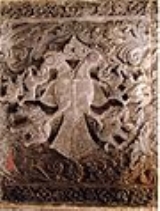
Political history of medieval Karnataka
Encyclopedia
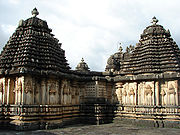
Karnataka
Karnataka , the land of the Kannadigas, is a state in South West India. It was created on 1 November 1956, with the passing of the States Reorganisation Act and this day is annually celebrated as Karnataka Rajyotsava...
region of India
India
India , officially the Republic of India , is a country in South Asia. It is the seventh-largest country by geographical area, the second-most populous country with over 1.2 billion people, and the most populous democracy in the world...
made a lasting impact on the subcontinent. Before this, alien empires held sway over the region, and the nucleus of power was outside modern Karnataka. The medieval era can be broadly divided into several periods: The earliest native kingdoms and imperialism; the successful domination of the Gangetic plains in northern India and rivalry with the empires of Tamilakam
Ancient Tamil country
The Sangam period is the classical period in the history of Tamil Nadu, Kerala and other parts of South India, spanning about the 3rd century BCE to the 3rd century CE...
over the Vengi
Vengi
The Vengi kingdom extended from the Godavari River in the north to Mount Mahendragiri in the southeast and to just south of the banks of River Krishna in the south of India. This area was part of Kalinga until that kingdom was conquered by Emperor Ashoka of the Mauryan Empire in the mid 3rd century...
region; and the domination of the southern Deccan and consolidation against Muslim invasion. The origins of the rise of the Karnataka region as an independent power date back to the fourth-century birth of the Kadamba Dynasty of Banavasi
Banavasi
Banavasi is an ancient temple town in Uttara Kannada District bordering Shivamogga district in the South Indian state of Karnataka .-History:Banavasi is one of the oldest towns in the Karnataka state...
, the earliest of the native rulers to conduct administration in the native language of Kannada in addition to the official Sanskrit
Sanskrit
Sanskrit , is a historical Indo-Aryan language and the primary liturgical language of Hinduism, Jainism and Buddhism.Buddhism: besides Pali, see Buddhist Hybrid Sanskrit Today, it is listed as one of the 22 scheduled languages of India and is an official language of the state of Uttarakhand...
. This is the historical starting point in studying the development of the region as an enduring geopolitical entity and of Kannada as an important regional language.
In the southern regions of Karnataka, the Western Gangas of Talakad
Talakad
Talakad is a desert-like town on the left bank of the Kaveri river at a spot where the river makes a sharp bend. It is 45 km from Mysore and 133 km from Bangalore in Karnataka, India. A historic site, Talakad once had over 30 temples that today are buried in sand. Now it is a scenic...
were contemporaries of the Kadambas. The Kadambas and Gangas were followed by the imperial dynasties of the Badami Chalukya Empire, the Rashtrakuta Empire, the Western Chalukya Empire, the Hoysala Empire
Hoysala Empire
The Hoysala Empire was a prominent South Indian Kannadiga empire that ruled most of the modern day state of Karnataka between the 10th and the 14th centuries. The capital of the Hoysalas was initially located at Belur but was later moved to Halebidu....
and the Vijayanagara Empire
Vijayanagara Empire
The Vijayanagara Empire , referred as the Kingdom of Bisnaga by the Portuguese, was an empire based in South Indian in the Deccan Plateau region. It was established in 1336 by Harihara I and his brother Bukka Raya I of the Yadava lineage. The empire rose to prominence as a culmination of attempts...
, all patronising the ancient Indic religions while showing tolerance to the new cultures arriving from the west of the subcontinent. The Muslim invasion of the Deccan resulted in the breaking away of the feudatory Sultanates in the 14th century. The rule of the Bahamani Sultanate of Bidar
Bidar
Bidar is a city in the Indian state of Karnataka. Located on the Deccan Plateau in the north-eastern part of Karnataka. It is the headquarters of the Bidar District....
and the Bijapur Sultanate from the northern Deccan region caused a mingling of the ancient Hindu traditions with the nascent Islamic culture in the region. The hereditary ruling families and clans ably served the large empires and upheld the local culture and traditions. The fall of the Vijayanagara Empire in 1565 brought about a slow disintegration of Kannada-speaking regions into minor kingdoms that struggled to maintain autonomy in an age dominated by foreigners until unification and independence in 1947.
Kadambas and Gangas
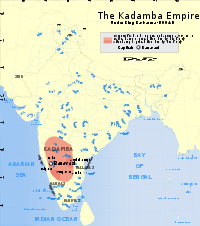
Banavasi
Banavasi is an ancient temple town in Uttara Kannada District bordering Shivamogga district in the South Indian state of Karnataka .-History:Banavasi is one of the oldest towns in the Karnataka state...
identified the Karnataka region as an independent political entity and Kannada as an administrative language from the middle of 5th century. The Kadambas were natives of the Talagunda
Talagunda
Talagunda is a village in the Shikaripura taluk of Shimoga district in the state of Karnataka, India. Many inscriptions found here have provided insights into the rise of the Kadamba Dynasty.-History:...
region (in modern Shivamogga district) as proven by inscriptions. Mayurasharma
Mayurasharma
Mayurasharma , a Brahmin scholar and a native of Talagunda , was the founder of the Kadamba Kingdom of Banavasi, the earliest native kingdom to rule over what is today the modern state of Karnataka, India. He took the name of Mayuravarma to emphasise his change from the Brahmin to the Kshatriya...
, a Brahmin native of Talagunda who was humiliated by a Pallava
Pallava
The Pallava dynasty was a Tamil dynasty which ruled the northern Tamil Nadu region and the southern Andhra Pradesh region with their capital at Kanchipuram...
guard, rose in rage against the Pallava control of the Banavasi region and declared his independence in 345. After many wars, the Pallava king had to accept the sovereignty of the Kadambas and Mayurasharma, the founding king, crowned himself at Banavasi (in the present day Uttara Kannada
Uttara Kannada
Uttara Kannada also known as North Canara or North Kanara, is a district in the southern Indian state of Karnataka. It is bordered by the state of Goa and Belgaum District to the north, Dharwad District and Haveri District to the east, Shimoga District and Udupi District to the south and the...
district).

Gupta Empire
The Gupta Empire was an ancient Indian empire which existed approximately from 320 to 550 CE and covered much of the Indian Subcontinent. Founded by Maharaja Sri-Gupta, the dynasty was the model of a classical civilization. The peace and prosperity created under leadership of Guptas enabled the...
dynasties attests to their power. Kakusthavarma
Kakusthavarma
Kakusthavarma was a ruler of the Kadamba Dynasty of Banavasi in Southern India during the 4th century. Under his rule, the dynasty attained the height of its greatness. Talagunda and Halmidi inscriptions praise him as a formidable Kadamba warrior. He was able to maintain a good relationship with...
, the most powerful ruler of the dynasty whom inscriptions describe as "ornament of the Kadamba family" and "Sun among the kings of wide spread flame", gave one daughter in marriage to Vakataka Narendrasena and another to Skandagupta
Skandagupta
Skandagupta was a Gupta Emperor of northern India. He is generally considered the last of the great Gupta Emperors.-Rule:Skandagupta's antecedents remain unclear. Later official genealogies omit his name, and even the inscriptions of his own age omit the name of his mother...
, grandson of Chandragupta II
Chandragupta II
Chandragupta II the Great, very often referred to as Vikramaditya or Chandragupta Vikramaditya in Sanskrit; was one of the most powerful emperors of the Gupta empire in northern India. His rule spanned c...
of the Gupta dynasty. Historians trace their rise to political power through the examination of the contemporaneous Sanskrit writing, Aichitya Vichara Charcha by Kshemendra, which quotes portions of a writing Kunthalesvara Dautya by the famous poet Kalidasa
Kalidasa
Kālidāsa was a renowned Classical Sanskrit writer, widely regarded as the greatest poet and dramatist in the Sanskrit language...
. Here Kalidasa describes his visit to the Kadamba kingdom as an ambassador where he was not offered a seat in the court of the Kadamba king and had to sit on the ground. Historians view this act as one of assertion by the Kadambas who considered themselves equal to the imperial Gupta dynasty.
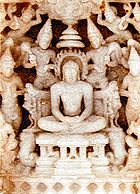
Belgaum district
Belgaum district is a district in the state of Karnataka, India. The city of Belgaum is the district headquarters in North Karnataka. By the 2011 Census of India, it had a population of 4778439...
. The most prominent feature of their architectural style, one that remained popular centuries later and was used by the Hoysalas and the Vijayanagar kings, is the Kadamba Shikara (Kadamba tower) with a Kalasa (pot) on top.
The Western Ganga Dynasty, contemporaries of the Kadambas, came to power from Kolar
Kolar
Kolara is a city in the South Indian state of Karnataka. It is the headquarters of Kolar District. It is known for being one of the gold mining sites in India....
but in the late 4th century - early 5th century moved their capital to Talakad
Talakad
Talakad is a desert-like town on the left bank of the Kaveri river at a spot where the river makes a sharp bend. It is 45 km from Mysore and 133 km from Bangalore in Karnataka, India. A historic site, Talakad once had over 30 temples that today are buried in sand. Now it is a scenic...
in modern Mysore district
Mysore district
Mysore District is an administrative district located in the southern part of the state of Karnataka, India. The district is bounded by Mandya district to the northeast, Chamrajanagar district to the southeast, Kerala state to the south, Kodagu district to the west, and Hassan district to the north...
. They ruled the region historically known as Gangavadi comprising most of the modern southern districts of Karnataka. Acting as a buffer state between the Kannada kingdoms of Karnataka region and the Tamil kingdoms of Tamilakam
Ancient Tamil country
The Sangam period is the classical period in the history of Tamil Nadu, Kerala and other parts of South India, spanning about the 3rd century BCE to the 3rd century CE...
, the Western Ganga architectural innovations show mixed influences. Their sovereign rule ended around the same time as the Kadambas when they came under the Badami Chalukya control. The Western Gangas continued to rule as a feudatory till the beginning of the eleventh century when they were defeated by the Cholas of Tanjavur. Important figures among the Gangas were King Durvinita
Durvinita
Durvinita is seen as the most successful ruler of the Western Ganga Dynasty. Son of the previous ruler, Avinita, Durvinita's assession to the throne was disputed by his brother, who had gained the support of the Pallavas and Kadambas. There are Nallala and Kadagattur inscriptions that refer to...
and Shivamara II
Shivamara II
Shivamara II was the son of Sripurusha and ruled the Western Ganga Dynasty from 788 - 816 C.E. He was also a noted scholar in Kannada, Sanskrit and Prakrit...
, admired as able warriors and scholars, and minister Chavundaraya
Chavundaraya
Chavundraya was a military commander, poet and a minister in the court of the Western Ganga Dynasty of Talakad . A person of many talents, in 982 he commissioned the Gomateshwara, a monolithic sculpture in Shravanabelagola, an important place of pilgrimage for Jains...
who was a builder, a warrior and a writer in Kannada and Sanskrit. The most important architectural contributions of these Gangas are the monuments and basadi
Basadi
Basadi is a Jain shrine or temple.The word is generally used in South India, including Maharashtra. Its historical use in North is preserved in the names of the Vimala Vasahi and Luna Vasahi temples of Mount Abu...
s of Shravanabelagola
Shravanabelagola
Shravana Belgola is a city located in the Hassan district in the Indian state of Karnataka and is 158 km from Bangalore. The statue of Gommateshvara Bahubali at Śravaṇa Beḷgoḷa is one of the most important pilgrimage destinations in Jainism, one that reached a peak in architectural and sculptural...
, the monolith
Monolith
A monolith is a geological feature such as a mountain, consisting of a single massive stone or rock, or a single piece of rock placed as, or within, a monument...
of Gomateshwara termed as the mightiest achievement in the field of sculpture in ancient Karnataka and the Panchakuta basadi ( five towers) at Kambadahalli
Kambadahalli
Kambadahalli is a village in Mandya district of Karnataka state, in southwestern India. Previously known as Kambapuri, it is one of the oldest and most important Jain religious centers in Karnataka. The monuments here were built by the Western Ganga Dynasty in the 9th - 10th century...
. Their free standing pillars (called Mahasthambhas and Brahmasthambhas) and Hero stone
Hero stone
Hero stone is a memorial commemorating the honorable death of a hero in battle of Tamil People. A hero stone can display a variety of adornments, including bas relief panels, statues, and figures of carved stone...
s (virgal) with sculptural detail are also considered a unique contribution.
Badami Chalukyas
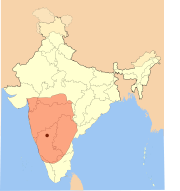
The Chalukya dynasty
Chalukya dynasty
The Chalukya dynasty was an Indian royal dynasty that ruled large parts of southern and central India between the 6th and the 12th centuries. During this period, they ruled as three related yet individual dynasties. The earliest dynasty, known as the "Badami Chalukyas", ruled from Vatapi from the...
, natives of the Aihole
Aihole
Aihole is a temple complex in the Bagalkot district of Karnataka, India. It is a very popular tourist spot in north Karnataka. It lies to the east of Pattadakal, along the Malaprabha River, while Badami is to the west of both....
and Badami
Badami
Badami , formerly known as Vatapi, is a town and headquarters of a taluk by the same name, in the Bagalkot district of Karnataka, India. It was the regal capital of the Badami Chalukyas from 540 to 757 AD. It is famous for rock cut and other structural temples...
region in Karnataka, were at first a feudatory of the Kadambas.
They encouraged the use of Kannada in addition to the Sanskrit language in their administration. In the middle of the 6th century the Chalukyas came into their own when Pulakesi I made the hill fortress in Badami his center of power. During the rule of Pulakesi II
Pulakesi II
Pulakesin II is the most famous ruler of the Chalukya dynasty. In his reign the Chalukyas of Badami saw their kingdom extend over most of the Deccan.-Early life and accession:...
a south Indian empire sent expeditions to the north past the Tapti River
Tapti River
The Tapi River ancient original name Tapi River , is a river in central India. It is one of the major rivers of peninsular India with a length of around 724 km...
and Narmada River
Narmada River
The Narmada , also called Rewa is a river in central India and the fifth largest river in the Indian subcontinent. It is the third largest river that completely flows within India after Ganges and Godavari...
for the first time and successfully defied Harshavardhana, the King of Northern India (Uttarapatheswara). The Aihole
Aihole
Aihole is a temple complex in the Bagalkot district of Karnataka, India. It is a very popular tourist spot in north Karnataka. It lies to the east of Pattadakal, along the Malaprabha River, while Badami is to the west of both....
inscription of Pulakesi II, written in classical Sanskrit language and old Kannada script dated 634, proclaims his victories against the Kingdoms of Kadambas, Western Gangas, Alupas
Alupas
The Alupas kings were a minor dynasty who ruled parts of coastal Karnataka. Later with the dominance of Kadambas in Banavasi, they became feudatory to them. With the changing political scenario, soon they became the feudatories to Chalukyas, Hoysalas and Vijayanagara Rayas...
of South Canara, Mauryas of Puri
Puri
Puri is district headquarter, a city situated about south of state capital Bhubaneswar, on the eastern coast of the Bay of Bengal in the Indian state of Orissa. It is also known as Jagannath Puri after the Jagannath Temple . It is a holy city of the Hindus as a part of the Char Dham pilgrimages...
, Kingdom of Kosala
Kaushal
The word Kaushal in Devnagri thesaurus means clever, perfect orskillful. Kaushal means "Excellence".Kaushal is also used as a name in parts of India and Nepal....
, Malwa, Lata and Gurjaras of southern Rajasthan
Rajasthan
Rājasthān the land of Rajasthanis, , is the largest state of the Republic of India by area. It is located in the northwest of India. It encompasses most of the area of the large, inhospitable Great Indian Desert , which has an edge paralleling the Sutlej-Indus river valley along its border with...
. The inscription describes how King Harsha of Kannauj
Kannauj
Kannauj , also spelt Kanauj, is a city, administrative headquarters and a municipal board or Nagar Palika Parishad in Kannauj district in the Indian state of Uttar Pradesh. The city's name is traditionally derived from the term Kanyakubja . Kannauj is an ancient city, in earlier times the capital...
lost his Harsha (joyful disposition) on seeing a large number of his war elephants die in battle against Pulakesi II.

Bay of Bengal
The Bay of Bengal , the largest bay in the world, forms the northeastern part of the Indian Ocean. It resembles a triangle in shape, and is bordered mostly by the Eastern Coast of India, southern coast of Bangladesh and Sri Lanka to the west and Burma and the Andaman and Nicobar Islands to the...
in present day Orissa. A Chalukya viceroyalty was set up in Gujarat and Vengi (coastal Andhra) and princes from the Badami family were dispatched to rule them. Having subdued the Pallavas of Kanchipuram, he accepted tributes from the Pandyas of Madurai
Madurai
Madurai is the third largest city in the Indian state of Tamil Nadu and one of the oldest continuously inhabited cities in the world. It served as the capital city of the Pandyan Kingdom. It is the administrative headquarters of Madurai District and is famous for its temples built by Pandyan and...
, Chola dynasty
Chola Dynasty
The Chola dynasty was a Tamil dynasty which was one of the longest-ruling in some parts of southern India. The earliest datable references to this Tamil dynasty are in inscriptions from the 3rd century BC left by Asoka, of Maurya Empire; the dynasty continued to govern over varying territory until...
and Chera
Chera dynasty
Chera Dynasty in South India is one of the most ancient ruling dynasties in India. Together with the Cholas and the Pandyas, they formed the three principle warring Iron Age Tamil kingdoms in southern India...
s of the Kerala region. Pulakesi II thus became the master of India, south of the Narmada River. Pulakesi II is widely regarded as one of the great kings in Indian history. Hiuen-Tsiang, a Chinese
China
Chinese civilization may refer to:* China for more general discussion of the country.* Chinese culture* Greater China, the transnational community of ethnic Chinese.* History of China* Sinosphere, the area historically affected by Chinese culture...
traveller visited the court of Pulakesi II at this time and Persian emperor Khosrau II
Khosrau II
250px|thumb|Khosrau II 250px|thumb|Khosrau II 250px|thumb|Khosrau II (Khosrow II, Chosroes II, or Xosrov II in classical sources, sometimes called Parvez, "the Ever Victorious" – (in Persian: خسرو پرویز), was the twenty-second Sassanid King of Persia, reigning from 590 to 628...
exchanged ambassadors. However, the continuous wars with Pallavas took a turn for the worse in 642 when the Pallava king Narasimhavarman I
Narasimhavarman I
Narasimhavarman I was a Tamil king of the Pallava dynasty who ruled South India from 630–668 CE. He shared his father Mahendravarman I's love of art and completed the work started by Mahendravarman in Mahabalipuram....
avenged his father's defeat, conquered and plundered the capital of Pulakesi II who may have died in battle. A century later, Chalukya Vikramaditya II
Vikramaditya II
Vikramaditya II was the son of King Vijayaditya and ascended the Badami Chalukya throne following the death of his father. This information comes from the Lakshmeshwar inscriptions in Kannada dated January 13 735...
marched victoriously into Kanchipuram
Kanchipuram
Kanchipuram, or Kanchi, is a temple city and a municipality in Kanchipuram district in the Indian state of Tamil Nadu. It is a temple town and the headquarters of Kanchipuram district...
, the Pallava capital and occupied it on three occasions, the third time under the leadership of his son and crown prince Kirtivarman II. He thus avenged the earlier humiliation of the Chalukyas by the Pallavas and engraved a Kannada inscription on the victory pillar at the Kailasanatha Temple. He later overran the other traditional kingdoms of Tamil country, the Pandyas, Cholas and Keralas in addition to subduing a Kalabhra ruler.
The Kappe Arabhatta
Kappe Arabhatta
Kappe Arabhatta was a Chalukya warrior of the 8th century who is known from a Kannada verse inscription, dated to c. 700 CE, and carved on a cliff overlooking the northeast end of the artificial lake in Badami, Karnataka, India. The inscription consists of five stanzas written out in ten lines in...
record from this period (700) in tripadi (three line) metre is considered the earliest available record in Kannada poetics. The most enduring legacy of the Chalukya dynasty is the architecture and art that they left behind. More than one hundred and fifty monuments attributed to the them, built between 450 and 700, have survived in the Malaprabha basin in Karnataka. The constructions are centred in a relatively small area within the Chalukyan heartland. The structural temples at Pattadakal
Pattadakal
Pattadakal is a village in Karnataka. It lies on the banks of the Malaprabha River in Bagalkot district. It is 22 km from Badami and about 10 km from Aihole...
, a UNESCO
UNESCO
The United Nations Educational, Scientific and Cultural Organization is a specialized agency of the United Nations...
World Heritage Site
World Heritage Site
A UNESCO World Heritage Site is a place that is listed by the UNESCO as of special cultural or physical significance...
, the cave temples of Badami
Badami
Badami , formerly known as Vatapi, is a town and headquarters of a taluk by the same name, in the Bagalkot district of Karnataka, India. It was the regal capital of the Badami Chalukyas from 540 to 757 AD. It is famous for rock cut and other structural temples...
, the temples at Mahakuta
Mahakuta group of temples
The Mahakuta group of temples is located in Mahakuta, a town in the Bagalkot district of Karnataka state, India. It is an important place of worship for Hindus and the location of a well-known Shaiva monastery. The temples are dated to the 6th or 7th century and were constructed by the early kings...
and early experiments in temple building at Aihole
Aihole
Aihole is a temple complex in the Bagalkot district of Karnataka, India. It is a very popular tourist spot in north Karnataka. It lies to the east of Pattadakal, along the Malaprabha River, while Badami is to the west of both....
are their most celebrated monuments. Two of the famous paintings at Ajanta
Ajanta
The Ajanta Caves in Aurangabad district of Maharashtra, India are 29 rock-cut cave monuments which date from the 2nd century BCE. The caves include paintings and sculptures considered to be masterpieces of both Buddhist religious art as well as frescos which are reminiscent of the Sigiriya...
cave no. 1, "The Temptation of the Buddha" and "The Persian Embassy" are also credited to them.
Further, they influenced the architecture in far off places like Gujarat and Vengi
Vengi
The Vengi kingdom extended from the Godavari River in the north to Mount Mahendragiri in the southeast and to just south of the banks of River Krishna in the south of India. This area was part of Kalinga until that kingdom was conquered by Emperor Ashoka of the Mauryan Empire in the mid 3rd century...
as evidenced in the Nava Brahma temples at Alampur.
Rashtrakutas
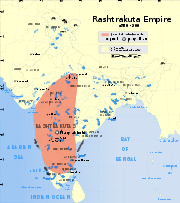
Berar Sultanate
-Berar in Ancient History:Subah Berar and Gondwana the Vidarbha region known as Gulshan-e-Berar in medieval period since Khilji dynasty to mughal period according Aine-Akbari and Alimgeer Namah report the berar is hole Fourteen sarkar...
(in present day Amravati district
Amravati district
Amravati district is a district of Maharashtra state in central India. Amravati is the administrative headquarters of the district.The district is situated between 20°32' and 21°46' north latitudes and 76°37' and 78°27' east longitudes. The district occupies an area of 12,235 km²...
of Maharashtra
Maharashtra
Maharashtra is a state located in India. It is the second most populous after Uttar Pradesh and third largest state by area in India...
). Sensing an opportunity during a weak period in the Chalukya rule, Dantidurga
Dantidurga
Dantidurga , also known as Dantivarman or Dantidurga II was the founder of the Rashtrakuta Empire of Manyakheta. His capital was based in Gulbarga region of Karnataka...
trounced the great Chalukyan "Karnatabala" (power of Karnata). Having overthrown the Chalukyas, the Rashtrakutas made Manyakheta
Manyakheta
Manyakheta on the banks of Kagina River in Gulbarga district, Karnataka state was the capital of Rashtrakutas from . It is 40 km from Gulbarga city. The capital was moved from Mayurkhandi in Bidar district to Mānyakheṭa during the rule of Amoghavarsha I...
their capital (modern Malkhed in Gulbarga district
Gulbarga District
Gulbarga district is one of the 30 districts of Karnataka state in southern India. Gulbarga city is the administrative headquarters of the district...
). Although the origins of the early Rashtrakuta ruling families in central India and the Deccan in the 6th and 7th centuries is controversial, during the eighth through the tenth centuries they emphasised the importance of the Kannada language in conjunction with Sanskrit in their administration. Rashtrakuta inscriptions are in Kannada and Sanskrit only. They encouraged literature in both languages and thus literature flowered under their rule.
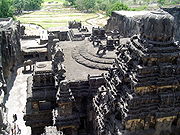
Doab
A Doab is a term used in India and Pakistan for a "tongue" or tract of land lying between two confluent rivers...
region of Ganges River
Ganges River
The Ganges or Ganga, , is a trans-boundary river of India and Bangladesh. The river rises in the western Himalayas in the Indian state of Uttarakhand, and flows south and east through the Gangetic Plain of North India into Bangladesh, where it empties into the Bay of Bengal. By discharge it...
and Jamuna River
Yamuna
The Yamuna is the largest tributary river of the Ganges in northern India...
during the rule of Dhruva Dharavarsha
Dhruva Dharavarsha
Dhruva was one of greatest ruler of the Rashtrakuta Empire. He ascended the throne after replacing his elder brother Govinda II. Govinda II had become unpopular among his subjects on account of his various misconducts and demeanors as a ruler, including excessive indulgence in sensual pleasure....
. The rule of his son Govinda III
Govinda III
Govinda III was a famous Rashtrakuta ruler who succeeded his illustrious father Dhruva Dharavarsha. He was militarily the most successful emperor of the dynasty with successful conquests from Cape Comorin in the south to Kannauj in the north, from Banaras in the east to Broach in the west...
signaled a new era with Rashtrakuta victories against the Pala Dynasty of Bengal
Bengal
Bengal is a historical and geographical region in the northeast region of the Indian Subcontinent at the apex of the Bay of Bengal. Today, it is mainly divided between the sovereign land of People's Republic of Bangladesh and the Indian state of West Bengal, although some regions of the previous...
and Gurjara Pratihara
Pratihara
The Gurjara Pratihara , often simply called Pratihara Empire, was an imperial Indian dynasty that ruled much of Northern India from the 6th to the 11th centuries. At its peak of prosperity and power , the Gurajara-Pratihara Empire rivaled or even exceeded the Gupta Empire in the extent of its...
of north western India resulting in the capture of Kannauj
Kannauj
Kannauj , also spelt Kanauj, is a city, administrative headquarters and a municipal board or Nagar Palika Parishad in Kannauj district in the Indian state of Uttar Pradesh. The city's name is traditionally derived from the term Kanyakubja . Kannauj is an ancient city, in earlier times the capital...
. The Rashtrakutas held Kannauj intermittently during a period of a tripartite struggle for the resources of the rich Gangetic plains. Because of Govinda III's victories, historians have compared him to Alexander the Great and Pandava
Pandava
In the Hindu epic Mahābhārata, the Pandava are the five acknowledged sons of Pandu , by his two wives Kunti and Madri. Their names are Yudhisthira, Bhima, Arjuna, Nakula and Sahadeva. Although, Karna is told by Lord Krishna that according to the laws and ethics he is the first son of Kunti making...
Arjuna
Arjuna
Arjuna in Indian mythology is the greatest warrior on earth and is one of the Pandavas, the heroes of the Hindu epic Mahābhārata. Arjuna, whose name means 'bright', 'shining', 'white' or 'silver' Arjuna (Devanagari: अर्जुन, Thai: อรชุน, Orachun, Tamil: Arjunan, Indonesian and Javanese: Harjuna,...
of the Hindu epic Mahabharata
Mahabharata
The Mahabharata is one of the two major Sanskrit epics of ancient India and Nepal, the other being the Ramayana. The epic is part of itihasa....
.
The Sanjan inscription states the horses of Govinda III drank the icy water of the Himalayan stream and his war elephants tasted the sacred waters of the Ganges River. Amoghavarsha I, eulogised by contemporary Arab traveller Sulaiman as one among the four great emperors of the world, succeeded Govinda III to the throne and ruled during an important cultural period that produced landmark writings in Kannada and Sanskrit. The benevolent development of Jain religion was a hallmark of his rule. Because of his religious temperament, his interest in the arts and literature and his peace loving nature, he has been compared to emperor Ashoka
Ashoka
Ashok Maurya or Ashoka , popularly known as Ashoka the Great, was an Indian emperor of the Maurya Dynasty who ruled almost all of the Indian subcontinent from ca. 269 BC to 232 BC. One of India's greatest emperors, Ashoka reigned over most of present-day India after a number of military conquests...
. The rule of Indra III
Indra III
Indra III was the grandson of Rashtrakuta Krishna II and son of Chedi princess Lakshmi. He became the ruler of the empire due to the early demise of his father Jagattunga. He had many titles such as Nithyavarsha, Rattakandarapa, Rajamarathanda and Kirthinarayana. He patronised Kannada poet and...
in the tenth century enhanced the Rashtrakuta position as an imperial power as they conquered and held Kannauj again. Krishna III
Krishna III
Krishna III, whose Kannada name was Kannara , was the last great warrior and able monarch of the Rashtrakuta Dynasty of Manyakheta. He was a shrewd administrator and skillful military campaigner. He waged many wars to bring back the glory of the Rashtrakutas and played an important role in...
followed Indra III to the throne in 939. A patron of Kannada literature and a powerful warrior, his reign marked the submission of the Paramara
Paramara
Paramara is a Maratha, Gurjar,& Rajput clan of India.The Paramara clan belongs to the Agnivansha of Rajputs ancient Kshatriyas...
of Ujjain
Ujjain
Ujjain , is an ancient city of Malwa region in central India, on the eastern bank of the Kshipra River , today part of the state of Madhya Pradesh. It is the administrative centre of Ujjain District and Ujjain Division.In ancient times the city was called Ujjayini...
in the north and Cholas in the south.
An Arabic writing Silsilatuttavarikh (851) called the Rashtrakutas one among the four principle empires of the world. Kitab-ul-Masalik-ul-Mumalik (912) called them the "greatest kings of India" and there were many other contemporaneous books written in their praise. The Rashtrakuta empire at its peak spread from Cape Comorin in the south to Kannauj in the north and from Banaras in the east to Broach (Bharuch) in the west.
While the Rashtrakutas built many fine monuments in the Deccan, the most extensive and sumptuous of their work is the monolithic Kailasanatha temple at Ellora, the temple being a splendid achievement. In Karnataka their most famous temples are the Kashivishvanatha temple and the Jain Narayana temple at Pattadakal. All of the monuments are designated UNESCO World Heritage Sites.
Western Chalukyas
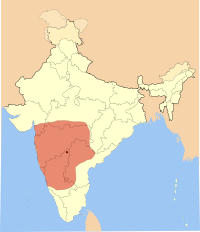
In the late 10th century, the Western Chalukyas, also known as the Kalyani Chalukyas or 'Later' Chalukyas rose to power by overthrowing the Rashtrakutas under whom they had been serving as feudatories. Manyakheta
Manyakheta
Manyakheta on the banks of Kagina River in Gulbarga district, Karnataka state was the capital of Rashtrakutas from . It is 40 km from Gulbarga city. The capital was moved from Mayurkhandi in Bidar district to Mānyakheṭa during the rule of Amoghavarsha I...
was their capital early on before they moved it to Kalyani (modern Basavakalyan
Basavakalyan
Basavakalyan is a town in Bidar District of the state of Karnataka, India, and was historically known as Kalyan.-History:Basavakalyan's history dates back to 3000 years with its name being mentioned in Guru Charitra....
). Whether the kings of this empire belonged to the same family line as their namesakes, the Badami Chalukyas is still debated. Whatever the Western Chalukya origins, Kannada remained their language of administration and the Kannada and Sanskrit literature of their time was prolific. Tailapa II
Tailapa II
Tailapa II had titles Nurmadi Taliapa and Satyashraya Kulatilaka. He re-established the Western Chalukya dynasty after a period of 220 years during which time they had been in eclipse. The revived Chalukya kingdom rose to its height of power under Vikramaditya VI. The revived dynasty came to be...
, a feudatory ruler from Tardavadi (modern Bijapur district), re-established the Chalukya rule by defeating the Rashtrakutas during the reign of Karka II
Karka II
Karka II succeeded his uncle Kottigga Amoghavarsha to the Rashtrakuta throne. He had military successes against the Gurjaras, Rajputs and his feudatory, the Western Ganga King Marasimha II defeated the Pallavas...
. He timed his rebellion to coincide with the confusion caused by the invading Paramara
Paramara
Paramara is a Maratha, Gurjar,& Rajput clan of India.The Paramara clan belongs to the Agnivansha of Rajputs ancient Kshatriyas...
of Central India to the Rashtrakutas capital in 973. This era produced prolonged warfare with the Chola dynasty of Tamilakam
Tamilakam
' refers to the classical era territory of old South Indian royalties covering modern Tamil Nadu, Kerala, Tamil Eelam and southern parts of Andhra Pradesh, Karnataka.; In an academic context, Tamilakam is used to refer to these territories as a single cultural area, where Tamil was the natural...
for control of the resources of the Godavari River
Godavari River
The Godavari is a river that runs from western to southern India and is considered to be one of the big river basins in India. With a length of 1465 km, it is the second longest river in India , that runs within the country and also the longest river in South India...
-Krishna River
Krishna River
The Krishna River , is one of the longest rivers in central-southern India, about . It is also referred to as Krishnaveni in its original nomenclature...
doab region in Vengi
Vengi
The Vengi kingdom extended from the Godavari River in the north to Mount Mahendragiri in the southeast and to just south of the banks of River Krishna in the south of India. This area was part of Kalinga until that kingdom was conquered by Emperor Ashoka of the Mauryan Empire in the mid 3rd century...
. Somesvara I
Somesvara I
Somesvara I succeeded his father Jayasimha II as the Western Chalukya king. He was one of the greatest kings of the later Chalukya Dynasty. In spite of many reverses he managed to safeguard the integrity of the Chalukya kingdom. He founded the city of Kalyani, present day Basavakalyana and moved...
, a brave Chalukyan king, successfully curtailed the growth of the Chola Empire to the south of the Tungabhadra River
Tungabhadra River
The Tungabhadra River is a sacred river in southern India that flows through the state of Karnataka to Andhra Pradesh, where it serves as the chief tributary of the Krishna River...
region despite suffering some defeats while maintaining control over his feudatories in the Konkan, Gujarat, Malwa and Kalinga
Kalinga
Kalinga is a landlocked province of the Philippines in the Cordillera Administrative Region in Luzon. Its capital is Tabuk and borders Mountain Province to the south, Abra to the west, Isabela to the east, Cagayan to the northeast, and Apayao to the north...
regions. For approximately 100 years, beginning in the early 11th century, the Cholas occupied large areas of South Karnataka region (Gangavadi).
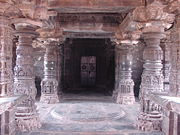
Vikramaditya VI
Vikramaditya VI became the Western Chalukya King after deposing his elder brother Somesvara II. Vikramaditya's reign is marked by the start of the Chalukya-Vikrama era. Vikramaditya VI was the greatest of the Western Chalukya kings and had the longest reign in the dynasty. He earned the title...
, changed the balance of power in favour of the Chalukyas. His fifty year reign was an important period in Karnataka's history and is referred to as the "Chalukya Vikrama era". His victories over the Cholas in the late 11th and early 12th centuries put an end to the Chola influence in the Vengi region permanently. Some of the well known contemporaneous feudatory families of the Deccan under Chalukya control were the Hoysalas, the Seuna Yadavas of Devagiri, the Kakatiya dynasty and the Southern Kalachuri. At their peak, the Western Chalukyas ruled a vast empire stretching from the Narmada River
Narmada River
The Narmada , also called Rewa is a river in central India and the fifth largest river in the Indian subcontinent. It is the third largest river that completely flows within India after Ganges and Godavari...
in the north to the Kaveri River
Kaveri River
The Kaveri , also spelled Cauvery in English, is a large Indian river. The origin of the river is traditionally placed at Talakaveri, Kodagu in the Western Ghats in Karnataka, flows generally south and east through Karnataka and Tamil Nadu and across the southern Deccan plateau through the...
in the south. Vikramaditya VI is considered one of the most influential kings of Indian history. Important architectural works were created by these Chalukyas, especially in the Tungabhadra river valley, that served as a conceptual link between the building idioms of the early Badami Chalukyas and the later Hoysalas. With the weakening of the Chalukyas in the decades following the death of Vikramaditya VI in 1126, the feudatories of the Chalukyas gained their independence.
The Kalachuri
Kalachuri
Kalachuri Empire is this the name used by two kingdoms who had a succession of dynasties from the 10th-12th centuries, one ruling over areas in Central India and were called Chedi or Haihaya and the other southern Kalachuri who ruled over parts of Karnataka...
s of Karnataka, whose ancestors were immigrants into the southern deccan from central India, had ruled as a feudatory from Mangalavada (modern Mangalavedhe in Maharashtra). Bijjala II
Bijjala II
Bijjala II 1130 - 1167 CE was the most famous of the southern Kalachuri kings and ruled initially as a feudatory of Chalukya Vikramaditya VI. He ruled as the Mahamandalesvara or chief and ruled over Karhada 4,000 and Tardavadi 1,000, designations given to...
, the most powerful ruler of this dynasty, was a commander (mahamandaleswar) during the reign of Chalukya Vikramaditya VI. Seizing an opportune moment in the waning power of the Chalukyas, Bijjala II declared independence in 1157 and annexed their capital Kalyani. His rule was cut short by his assassination in 1167 and the ensuing civil war caused by his sons fighting over the throne ended the dynasty as the last Chalukya scion regained control of Kalyani. This victory however, was short-lived as the Chalukyas were eventually driven out by the Seuna Yadavas.
Hoysalas

Belur
Belur may refer to any of the following:* Belur, Karnataka, town in Karnataka, India* Belur, West Bengal, India, a locality on the west bank of the Hooghly River* Belur Math, the religious abbey located in Belur, West Bengal, India...
in the 11th century as a feudatory of the Chalukyas (in the south Karnataka region). In the early 12th century they successfully fought the Cholas in the south, convincingly defeating them in the battle of Talakad
Talakad
Talakad is a desert-like town on the left bank of the Kaveri river at a spot where the river makes a sharp bend. It is 45 km from Mysore and 133 km from Bangalore in Karnataka, India. A historic site, Talakad once had over 30 temples that today are buried in sand. Now it is a scenic...
and moved their capital to nearby Halebidu
Halebidu
Halebidu is located in Hassan District, Karnataka, India. Halebidu was the regal capital of the Hoysala Empire in the 12th century. It is home to one of the best examples of Hoysala architecture in the ornate Hoysaleswara and Kedareswara temples. Halebidu literally means ruined city...
. Historians refer to the founders of the dynasty as natives of Malnad
Malnad
Malenadu is a region of Karnataka state in South India. Malenadu covers the western and eastern slopes of the Western Ghats, roughly 100 kilometers in width. Malenadu covers portions of the Shimoga, Chikmagalur, Uttara Kannada, Kodagu and Hassan districts....
Karnataka, based on the numerous inscriptions calling them Maleparolganda or "Lord of the Male (hills) chiefs" (Malepas). With the waning of the Western Chalukya power, the Hoysalas declared their independence in the late twelfth century.

Vesara
Vesara is a type of Indian architecture primarily used in temples. The two other prominent styles are Dravida and Nagara. Vesara is a combination of these two temple styles.-Description:...
architecture stemming from the Chalukyas, culminating in the Hoysala architectural articulation and style as exemplified in the construction of the Chennakesava Temple
Chennakesava Temple
The Chennakesava Temple originally called Vijayanarayana Temple was built on the banks of the Yagachi River in Belur, an early capital of the Hoysala Empire. Belur is 40 km from Hassan city and 220 km from Bangalore, in Hassan district of Karnataka state, India. Chennakesava literally...
at Belur and the Hoysaleswara temple
Hoysaleswara temple
Hoysaleswara temple is a temple dedicated to Hindu God Shiva. It was built in Halebidu during the Hoysala Empire rule in the 12th century by King Vishnuvardhana. The construction was completed in 1121 CE. During the early 14th century, Halebidu was sacked and looted by Muslim invaders from...
at Halebidu. Both these temples were built in commemoration of the victories of the Hoysala Vishnuvardhana
Vishnuvardhana
Vishnuvardhana was an emperor of the Hoysala Empire in present day Indian state of Karnataka. Vishnuvardhana took the first step in consolidating the Hoysala Empire in South India through a series of battles against his overlords, the Western Chalukya empire...
against the Cholas in 1116. Veera Ballala II
Veera Ballala II
Veera Ballala II was the greatest monarch of the Hoysala Empire. This is proven by his successes against the Seuna, Southern Kalachuri, and the waning Kalyani Chalukya dynasties. He caused the demise of the Kalyani Chalukya dynasty. His period also saw prolific literary activity in Kannada. He...
, the most effective of the Hoysala rulers, defeated the aggressive Pandya when they invaded the Chola kingdom and assumed the titles "Establisher of the Chola Kingdom"
(Cholarajyapratishtacharya), "Emperor of the south" (Dakshina Chakravarthi) and "Hoysala emperor" (Hoysala Chakravarthi). The Hoysalas extended their foothold in areas known today as Tamil Nadu around 1225, making the city of Kannanur Kuppam near Srirangam
Srirangam
Srirangam , Old name is Vellithirumutha gramam and Tamil name is Thiruvarangam , is an island and a part of the city of Tiruchirapalli , in South India....
a provincial capital. This gave them control over South Indian politics that began a period of Hoysala hegemony in the southern Deccan.
In the early 13th century, with the Hoysala power remaining unchallenged, the first of the Muslim
Muslim
A Muslim, also spelled Moslem, is an adherent of Islam, a monotheistic, Abrahamic religion based on the Quran, which Muslims consider the verbatim word of God as revealed to prophet Muhammad. "Muslim" is the Arabic term for "submitter" .Muslims believe that God is one and incomparable...
incursions into South India
South India
South India is the area encompassing India's states of Andhra Pradesh, Karnataka, Kerala and Tamil Nadu as well as the union territories of Lakshadweep and Pondicherry, occupying 19.31% of India's area...
began. After over two decades of waging war against a foreign power, the Hoysala ruler at the time, Veera Ballala III
Veera Ballala III
Veera Ballala III was the last great king of the Hoysala Empire that ruled over what is now the South Indian state of Karnataka. Veera Ballala's commanders, Harihara and Bukkaraya are perhaps better known in Kannada folklore as the founders of the Vijayanagar Empire...
, died in the battle of Madurai
Madurai
Madurai is the third largest city in the Indian state of Tamil Nadu and one of the oldest continuously inhabited cities in the world. It served as the capital city of the Pandyan Kingdom. It is the administrative headquarters of Madurai District and is famous for its temples built by Pandyan and...
in 1343. This resulted in the merger of the sovereign territories of the Hoysala empire with the areas administered by Harihara I
Harihara I
Harihara I , also called Hakka ಹಕ್ಕ and Vira Harihara I, was the founder of the Vijayanagara empire. He was Bhavana Sangama’s eldest son, belonged to the Kuruba clan and was founder of the Sangama dynasty, the first among the four dynasties that ruled Vijayanagara...
, founder of the Vijayanagara Empire
Vijayanagara Empire
The Vijayanagara Empire , referred as the Kingdom of Bisnaga by the Portuguese, was an empire based in South Indian in the Deccan Plateau region. It was established in 1336 by Harihara I and his brother Bukka Raya I of the Yadava lineage. The empire rose to prominence as a culmination of attempts...
, located in the Tungabhadra region in present day Karnataka. The new kingdom thrived for another two centuries with Vijayanagara
Vijayanagara
Vijayanagara is in Bellary District, northern Karnataka. It is the name of the now-ruined capital city "which was regarded as the second Rome" that surrounds modern-day Hampi, of the historic Vijayanagara empire which extended over the southern part of India....
as its capital.
Vijayanagara Empire
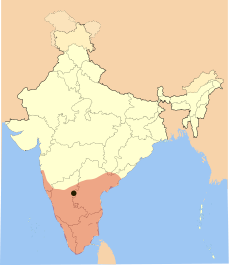
Sri Lanka
Sri Lanka, officially the Democratic Socialist Republic of Sri Lanka is a country off the southern coast of the Indian subcontinent. Known until 1972 as Ceylon , Sri Lanka is an island surrounded by the Indian Ocean, the Gulf of Mannar and the Palk Strait, and lies in the vicinity of India and the...
paid tributes and ambassadors were exchanged with the Ming Dynasty
Ming Dynasty
The Ming Dynasty, also Empire of the Great Ming, was the ruling dynasty of China from 1368 to 1644, following the collapse of the Mongol-led Yuan Dynasty. The Ming, "one of the greatest eras of orderly government and social stability in human history", was the last dynasty in China ruled by ethnic...
of China. The empire's most famous rulers were Deva Raya II
Deva Raya II
Deva Raya II was an emperor of the Vijayanagara Empire from the Sangama Dynasty. Perhaps the greatest of the Sangama dynasty rulers, he patronised some of the famous Kannada and Telugu poets of the time...
and the Tuluva
Tuluva
The Tuluva -Geographic Distribution :Though most of the Tuluva population is found in the Tulu Nadu region, migrant poplulations are found the world over. In recent times, the first period of migration started at the beginning of the 20th century to places such as Mumbai and Chennai and other...
king Krishnadevaraya
Krishnadevaraya
Śrī Kriṣhṇa Devarāya , , , and also known as Krishna Devarayulu in some inscriptions was the famed Emperor of the Vijayanagara Empire who reigned from 1509–1529 CE.He is the third ruler of the Tuluva Dynasty. Presiding over the empire at its zenith, he is regarded as an icon by many Indians...
. Deva Raya II (known as Gajabetekara or hunter of elephants) ascended the throne in 1424 and was the most effective of the Sangama dynasty
Sangama Dynasty
The Sangama Dynasty was the first dynasty of the Vijayanagara Empire. Founded by the brothers, Harihara I and Bukka Raya I, they were sons of Bhavana Sangama...
rulers. He quelled rebelling feudal lords, the Zamorin of Calicut and the Quilon
Quilon
Quilon may refer to,* Venad, a former state on Malabar Coast, India* Kollam , Kerala state, India* Kollam district, Kerala state...
in the south, and invaded the island of Lanka
Sri Lanka
Sri Lanka, officially the Democratic Socialist Republic of Sri Lanka is a country off the southern coast of the Indian subcontinent. Known until 1972 as Ceylon , Sri Lanka is an island surrounded by the Indian Ocean, the Gulf of Mannar and the Palk Strait, and lies in the vicinity of India and the...
while becoming overlord of the kings of Burma at Pegu and Tanasserim. After a brief decline, the empire reached its peak in early 16th century during the rule of Krishnadevaraya
Krishnadevaraya
Śrī Kriṣhṇa Devarāya , , , and also known as Krishna Devarayulu in some inscriptions was the famed Emperor of the Vijayanagara Empire who reigned from 1509–1529 CE.He is the third ruler of the Tuluva Dynasty. Presiding over the empire at its zenith, he is regarded as an icon by many Indians...
when the Vijayanagara armies were consistently victorious. The empire annexed areas formerly under the Sultanates in the northern Deccan and the territories in the eastern Deccan, including Kalinga, while simultaneously maintaining control over all its subordinates in the south.
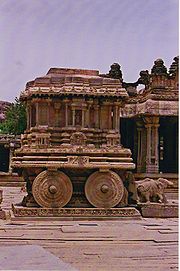
Hampi
Hampi is a village in northern Karnataka state, India. It is located within the ruins of Vijayanagara, the former capital of the Vijayanagara Empire. Predating the city of Vijayanagara, it continues to be an important religious centre, housing the Virupaksha Temple, as well as several other...
were either completed or commissioned during the reign of Krishnadevaraya. The enduring legacy of this empire is the vast open air theatre of monuments at the regal capital, Vijayanagara
Vijayanagara
Vijayanagara is in Bellary District, northern Karnataka. It is the name of the now-ruined capital city "which was regarded as the second Rome" that surrounds modern-day Hampi, of the historic Vijayanagara empire which extended over the southern part of India....
, which is now a UNESCO World Heritage site. Vijayanagara architecture is a vibrant blend of the preceding Chalukya, Hoysala, Pandya and Chola styles. Literature in Telugu, Kannada, Tamil and Sanskrit languages found royal patronage. Telugu attained its height in popularity and reached its peak under Krishnadevaraya. The Kannada Haridasa
Haridasa
The Haridasa devotional movement is considered as one of the turning points in the cultural history of India. Over a span of nearly six centuries, several saints and mystics helped shape the culture, philosophy and art of South India and Karnataka in particular by exerting considerable spiritual...
movement contributed greatly to Carnatic music
Carnatic music
Carnatic music is a system of music commonly associated with the southern part of the Indian subcontinent, with its area roughly confined to four modern states of India: Andhra Pradesh, Karnataka, Kerala, and Tamil Nadu...
and fostered a strong Hindu sentiment across South India. With the defeat of the Vijayanagara Empire in the Battle of Talikota
Battle of Talikota
The Battle of Talikota , a watershed battle fought between the Vijayanagara Empire and the Deccan sultanates, resulted in a rout of Vijayanagara, and ended the last great Hindu kingdom in South India...
in 1565 by the Deccan sultanates, the Karnataka region and South India in general became fragmented and subsumed under the rule of various former feudatories of the empire. A diminished Vijayanagara Empire moved its capital to Penukonda in modern Andhra Pradesh and later to Chandragiri
Chandragiri
Chandragiri , is a suburb of Tirupati in Andhra Pradesh, India. Recently it is included under Municipal Corporation limits of Tirupati...
and Vellore
Vellore
Vellore It is considered one of the oldest cities in South India and lies on the banks of the Palar river on the site of Vellore Fort. The city lies between Chennai and Bangalore and the Temple towns of Thiruvannamalai and Tirupati...
before disintegrating. In the south and coastal Karnataka region, the Kingdom of Mysore
Kingdom of Mysore
The Kingdom of Mysore was a kingdom of southern India, traditionally believed to have been founded in 1399 in the vicinity of the modern city of Mysore. The kingdom, which was ruled by the Wodeyar family, initially served as a vassal state of the Vijayanagara Empire...
and the Keladi Nayaka
Keladi Nayaka
Keladi Nayaka Kingdom were an important ruling dynasty of post-medieval Karnataka, India. They initially started to rule as a feudatory of the Vijayanagar Empire...
of Shimoga held sway while the northern regions were under the control of the Bijapur Sultanate. The Nayaka kingdom lasted into the 18th century before merging with the Kingdom of Mysore which remained a princely state until Indian independence in 1947, though they came under the British Raj (rule) in 1799 following the defeat and death of the last independent Mysore king, Tipu Sultan.
Bahmani Sultanate
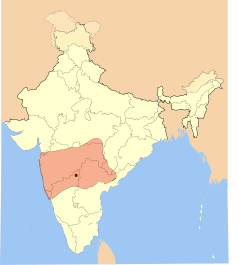
Bahmani Sultanate
The Bahmani Sultanate was a Muslim state of the Deccan in southern India and one of the great medieval Indian kingdoms...
, a contemporary of the Vijayanagara Empire, was founded in 1347 by Alla-ud-din-Hasan, a breakaway commander of the armies of the northern invaders led by Mohammed-bin-Tughlaq
Muhammad bin Tughluq
Muhammad bin Tughluq was the Turkic Sultan of Delhi from 1325 to 1351. He was the eldest son of Ghiyas-ud-din Tughlaq.He was born in Kotla Tolay Khan in Multan. His wife was daughter of the raja of Dipalpur...
. The capital was Gulbarga
Gulbarga
Gulbarga is a city in the Indian state of Karnataka. It is the administrative headquarters of Gulbarga District. It was formerly part of Nizam's Hyderabad state...
but was later moved further north to Bidar
Bidar
Bidar is a city in the Indian state of Karnataka. Located on the Deccan Plateau in the north-eastern part of Karnataka. It is the headquarters of the Bidar District....
in 1430. The first of the Muslim invasions of the Deccan came in the early decades of the 14th century. At its peak, the Bahamani kingdom extended from the Krishna River
Krishna River
The Krishna River , is one of the longest rivers in central-southern India, about . It is also referred to as Krishnaveni in its original nomenclature...
in the south to Penganga River in the north, thus covering the regions of northern parts of modern Karnataka, parts of Maharashtra
Maharashtra
Maharashtra is a state located in India. It is the second most populous after Uttar Pradesh and third largest state by area in India...
and Andhra Pradesh
Andhra Pradesh
Andhra Pradesh , is one of the 28 states of India, situated on the southeastern coast of India. It is India's fourth largest state by area and fifth largest by population. Its capital and largest city by population is Hyderabad.The total GDP of Andhra Pradesh is $100 billion and is ranked third...
. The most famous of the Bahamani Kings was Firuz Shah (also known as Taj Ud Din Firuz), who ruled from 1397 to 1422. Militarily, the rule of Firuz Shah had uneven success against the Vijayanagara kings while he was more convincingly successful against the Kherla rulers of Madhya Pradesh
Madhya Pradesh
Madhya Pradesh , often called the Heart of India, is a state in central India. Its capital is Bhopal and Indore is the largest city....
and the Vema Reddies of Rajamundry, areas that he annexed in 1417. His last encounter with the Vijayanagara armies in 1417 was disastrous and led to his defeat, ill health and ultimate death in 1422.
Contemporary writers such as Tabataba, in his writings have heaped praise on Firuz Shah. Tabataba wrote of the king as, "[a]n impetuous, mighty monarch who patronised learned men, Sheiks and hermits", while Shirazi described him as "a just, pious and generous king and one without equal". He has earned the honorific Sultan-i-ghazian for his bravery, tolerant nature and patronage of the fine arts. In the opinion of one historian, Firuz Shah was one of the most notable Sultans to rule in India. Another well known figure from this kingdom was Kwaja Mahamud Gavan, the prime minister, who served under several kings and regents. He rose above the kings and princess of the dynasty by virtue of his ministerial, administrative, martial, literary and philanthropic abilities. A Persian by descent and a visitor to Bidar in 1445, he impressed the ruling Sultan Alla-ud-din II and was chosen to become a minister in his court. As a commander he was able to extend the kingdom from Hubli in the south to Goa in the west and Kondavidu and Rajamahendri in the east. He soon rose to the position of prime minister (Vakil-Us-Sultanat).
The Bahamanis introduced the large scale use of paper in administration and began the Indo-Sarasenic architectural style, designed and constructed by Persian architects and artisans, (also known as Deccani architecture) with its local influences in Karnataka. The Sultanate monuments of Bidar and Gulbarga are testimony to their interest in architecture. The Bande Nawaz tombs and a Jama Masjid in Gulbarga which exhibits a Spanish influence are well known. In Bidar, their buildings have Persian, Turkish, Arabic and Roman influences (the Solah Khamba mosque being an example). Rangin Mahal, Gangan Mahal, Tarkash Mahal, Chini Mahal, Nagina Mahal and the Taqk Mahal are some of the palaces built by them that have retained their beauty. The Ahmad Shah Wali tombs are noted for their decor, and the school of learning (madrasa) built by Gavan in Bidar (1472), with its lecture halls, library, mosque and residential houses are also famous. In the later part of 15th century, with a growing rift between the local Deccani Muslims and the Pardeshi Muslims (foreign) who occupied influential positions in the kingdom, the execution of Gavan under dubious circumstances in 1481, and constant wars with the Vijayanagara kings weakened the Bahamani Kingdom eventually bringing about its end in 1527.
Bijapur Sultanate
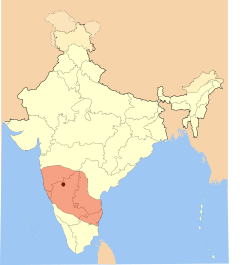
Turkic peoples
The Turkic peoples are peoples residing in northern, central and western Asia, southern Siberia and northwestern China and parts of eastern Europe. They speak languages belonging to the Turkic language family. They share, to varying degrees, certain cultural traits and historical backgrounds...
general in the Bahmani army, broke away to found the kingdom from modern Bijapur . Throughout his rule, the Sultanate was at war with the Vijayanagara Empire over the strategic Raichur
Raichur
Raichur , is a city municipal council in Raichur district in the Indian state of Karnataka. Raichur, on the banks of the Tungabhadra River, is the headquarters of Raichur district. It was in the princely state of Mysore during the rule of Tipu Sultan...
doab, with the Portuguese over Goa
Goa
Goa , a former Portuguese colony, is India's smallest state by area and the fourth smallest by population. Located in South West India in the region known as the Konkan, it is bounded by the state of Maharashtra to the north, and by Karnataka to the east and south, while the Arabian Sea forms its...
, with the Barid Shahis of Bidar and later with the erstwhile feudatories of the Vijayanagara Empire who had gained independence after 1565. The Italian
Italy
Italy , officially the Italian Republic languages]] under the European Charter for Regional or Minority Languages. In each of these, Italy's official name is as follows:;;;;;;;;), is a unitary parliamentary republic in South-Central Europe. To the north it borders France, Switzerland, Austria and...
writer Varathema wrote about the founder Adilkhan and Bijapur, "A powerful and prosperous king", "the city was encircled by many fortifications and contained beautiful and majestic buildings".
Inter-Sultanate marriages normalised relations and Ali I (1557–1580) joined a confederacy of Sultanates who eventually inflicted a crushing defeat on the Vijayanagara Empire in 1565. The most notable ruler of the dynasty was Ibrahim II (1580–1626) who ascended the throne as a nine year old with Chandbibi, the king's aunt acting as the regent. Later when Ibrahim II was defeated by the first of the Moghul incursions into the Deccan, he gave his daughter in marriage to Daniyal, a son of Emperor Akbar, but managed to collect tributes from the former feudatories of the Vijayanagara Empire. According to a historian, the rule of Ibrahim II was the high point of the Bijapur Sultanate. A tolerant king inclined to the fine arts, the earliest book on music in Urdu language called Kitab-e-Nauras is ascribed to him. The opening song in the book is an invocation of the Hindu Goddess Saraswati
Saraswati
In Hinduism Saraswati , is the goddess of knowledge, music, arts, science and technology. She is the consort of Brahma, also revered as His Shakti....
. During the rule of his son Muhammad, Shahji Bhosle from Ahmadnagar
Ahmadnagar
Ahmadnagar is located in Gujranwala DistricTt, Punjab, Pakistan.-References:...
joined the Bijapur army and along with commander Ranadullah Khan conducted many successful campaigns in the southern Deccan collecting tribute from local rulers there. The final end of the diminished Vijayanagara Empire ruling from Vellore
Vellore
Vellore It is considered one of the oldest cities in South India and lies on the banks of the Palar river on the site of Vellore Fort. The city lies between Chennai and Bangalore and the Temple towns of Thiruvannamalai and Tirupati...
came during these campaigns.
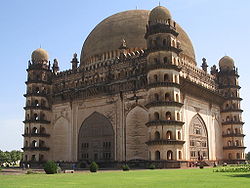
Maratha Empire
The Maratha Empire or the Maratha Confederacy was an Indian imperial power that existed from 1674 to 1818. At its peak, the empire covered much of South Asia, encompassing a territory of over 2.8 million km²....
Shivaji and constant invasions by the Mughals
Mughal (tribe)
The term Mughal is simply a Turkic word and many groups in India, Pakistan, Afghanistan, and Bangladesh use the term Mughal to describe themselves...
from the north took its toll on the kingdom, eventually bringing it to an end in the later part of 17th century. The contributions of the Bijapur Sultanate in the Indo-Saracenic idiom to the architectural landscape of Karnataka is noteworthy. Their most famous monuments are the mausoleums called Ibrahim Rauza and the Gol Gumbaz
Gol Gumbaz
Gol Gumbaz is the mausoleum of Mohammed Adil Shah, Sultan of Bijapur. The tomb, located in Bijapur, Karnataka in southern India, was completed in 1656 by the architect Yaqut of Dabul...
apart from many other palaces and mosques. The elegance, finish and beauty of Mehtar Mahal is claimed by a historian to be equal to anything in Cairo
Cairo
Cairo , is the capital of Egypt and the largest city in the Arab world and Africa, and the 16th largest metropolitan area in the world. Nicknamed "The City of a Thousand Minarets" for its preponderance of Islamic architecture, Cairo has long been a centre of the region's political and cultural life...
. Their Kali Masjid at Lakshmeshwar
Lakshmeshwar
Lakshmeshwara is a town in Shirahatti taluk, Gadag district, North Karnataka, in the Indian state of Karnataka. It is about 50 km from Gadag and 55 km from Hubli. Lakshmeshwara is an agricultural trading town....
is a synthesis of Hindu and Muslim styles. The Ibrahim Rauza built by Ibrahim II is a combination of a mausoleum and a mosque and is called the "Taj Mahal
Taj Mahal
The Taj Mahal is a white Marble mausoleum located in Agra, India. It was built by Mughal emperor Shah Jahan in memory of his third wife, Mumtaz Mahal...
of the Deccan". The Gol Gumbaz
Gol Gumbaz
Gol Gumbaz is the mausoleum of Mohammed Adil Shah, Sultan of Bijapur. The tomb, located in Bijapur, Karnataka in southern India, was completed in 1656 by the architect Yaqut of Dabul...
built by Muhammad is the largest dome in India and the second largest pre-modern dome in the world after the Byzantine Hagia Sophia
Hagia Sophia
Hagia Sophia is a former Orthodox patriarchal basilica, later a mosque, and now a museum in Istanbul, Turkey...
with an impressive "whispering gallery". Some historians consider this one of the architectural marvels of the world. Persian language was given state patronage while the use of the local languages, Kannada and Marathi was popularised in local affairs.
Modern era
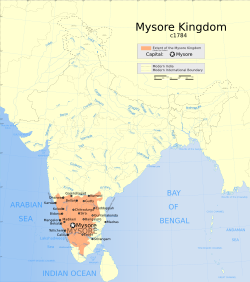

Battle of Talikota
The Battle of Talikota , a watershed battle fought between the Vijayanagara Empire and the Deccan sultanates, resulted in a rout of Vijayanagara, and ended the last great Hindu kingdom in South India...
started a slow disintegration of the Kannada speaking region into many short-lived palegar chiefdoms, and the better known Kingdom of Mysore
Kingdom of Mysore
The Kingdom of Mysore was a kingdom of southern India, traditionally believed to have been founded in 1399 in the vicinity of the modern city of Mysore. The kingdom, which was ruled by the Wodeyar family, initially served as a vassal state of the Vijayanagara Empire...
and the kingdom of Keladi Nayaka
Keladi Nayaka
Keladi Nayaka Kingdom were an important ruling dynasty of post-medieval Karnataka, India. They initially started to rule as a feudatory of the Vijayanagar Empire...
s, which were to later become important centres of Kannada literary production. These kingdoms and the Nayakas ("chiefs") of Tamil country continued to owe nominal support to a diminished Vijayanagara Empire ruling from Penukonda
Penukonda
Penukonda or Penu Konda is a small town in the Anantapur district of Andhra Pradesh, India. It is 70 km away from Anantapur town.-Geography:Penukonda is located at...
(1570) and later from Chandragiri
Chandragiri
Chandragiri , is a suburb of Tirupati in Andhra Pradesh, India. Recently it is included under Municipal Corporation limits of Tirupati...
(1586) in modern Andhra Pradesh
Andhra Pradesh
Andhra Pradesh , is one of the 28 states of India, situated on the southeastern coast of India. It is India's fourth largest state by area and fifth largest by population. Its capital and largest city by population is Hyderabad.The total GDP of Andhra Pradesh is $100 billion and is ranked third...
, followed by a brief period of independence. By mid-17th century, large areas in north Karnataka came under the control of the Bijapur Sultanate who waged several wars in a bid to establish a hegemony over the southern Deccan. The defeat of the Bijapur Sultanate at the hands of the Mughals in late 17th century added a new dimension to the prevailing confusion. The constant wars of the local kingdoms with the two new rivals, the Mughals and the Marathas, and among themselves, caused further instability in the region. Major areas of Karnataka came under the rule of the Mughals and the Marathas. Under Hyder Ali
Hyder Ali
Hyder Ali was the de facto ruler of the Kingdom of Mysore in southern India. Born Hyder Naik, he distinguished himself militarily, eventually drawing the attention of Mysore's rulers...
and his son Tipu Sultan
Tipu Sultan
Tipu Sultan , also known as the Tiger of Mysore, was the de facto ruler of the Kingdom of Mysore. He was the son of Hyder Ali, at that time an officer in the Mysorean army, and his second wife, Fatima or Fakhr-un-Nissa...
, the Mysore Kingdom reached its zenith of power but had to face the growing English might who by now had a firm foothold in the subcontinent. After the death of Tipu Sultan in 1799 in the fourth Anglo-Mysore war, the Mysore Kingdom came under the British umbrella. More than a century later, with the dawn of India as an independent nation in 1947, the unification of Kannada speaking regions
Unification of Karnataka
The Unification of Karnataka refers to the formation of the Indian state of Karnataka, then called as Mysore State, in 1956 when several Indian states were created by redrawing borders based on linguistic demographics...
as modern Karnataka state brought four centuries of political uncertainty (and centuries of foreign rule) to an end.
See also
- History of IndiaHistory of IndiaThe history of India begins with evidence of human activity of Homo sapiens as long as 75,000 years ago, or with earlier hominids including Homo erectus from about 500,000 years ago. The Indus Valley Civilization, which spread and flourished in the northwestern part of the Indian subcontinent from...
- History of BiharHistory of BiharThe history of Bihar is one of the most varied in India. Ancient Bihar, known as Magadha, was the center of power, learning, and culture in India for 1000 years. India's first empire, the Maurya empire as well as one of the world's greatest pacifist religion, Buddhism arose from the region that now...
- History of BengalHistory of BengalThe history of Bengal includes modern day Bangladesh and West Bengal, dates back four millennia. To some extent, the Ganges and the Brahmaputra rivers separated it from the mainland of India, though at times, Bengal has played an important role in the history of India.- Etymology :The exact origin...
- History of Tamil NaduHistory of Tamil NaduThe region of Tamil Nadu in modern India has been under continuous human habitation since prehistoric times, and the history of Tamil Nadu and the civilization of the Tamil people are among the oldest in the world. Throughout its history, spanning the early Paleolithic age to modern times, this...
- Karnataka History TimelineKarnataka History TimelineThe name Karnataka is derived from "Karunadu" which means Loftyland . As Karnataka lies in the middle of Deccan plateau the name is justified. The name can also mean "Land of black soil" in Kannada. The history of Karnataka goes back to epics "Ramayana" and "Mahabharatha"...

